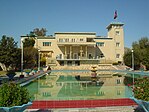Jelalabad
|
Jalalabad جلال اباد Adinapur |
|||||||||
|---|---|---|---|---|---|---|---|---|---|
From top left to right: A panoramic view of a section of Jalalabad; Jalalabad Bridge; Jalalabad Cricket Stadium; Pashtunistan Square; Mosque in Jalalabad; Governor's House in Jalalabad; Building on a main road.
|
|||||||||
| Location in Afghanistan | |||||||||
| Coordinates: 34°26′03″N 70°26′52″E / 34.43417°N 70.44778°ECoordinates: 34°26′03″N 70°26′52″E / 34.43417°N 70.44778°E | |||||||||
| Country | Afghanistan | ||||||||
| Province | Nangarhar Province | ||||||||
| Founded | 1570 | ||||||||
| Government | |||||||||
| • Mayor | Hamidullah Afghan | ||||||||
| Elevation | 575 m (1,886 ft) | ||||||||
| Population (2014) | |||||||||
| • City | 356,275 | ||||||||
| • Urban | 356,274 | ||||||||
| Time zone | UTC+4:30 | ||||||||
Jalālābād /dʒəˈlæləˌbæd/ (Pashto/Persian: جلال اباد), formerly called Ādīnapūr (Pashto: آدينه پور) as documented by the 7th century Hsüan-tsang, is the capital city of Nangarhar Province in eastern Afghanistan. Jalalabad is located at the junction of the Kabul River and Kunar River. It is linked by an approximately 150 kilometres (95 mi) highway with Kabul to the west, and a 130 kilometres (80 mi) highway with Peshawar, Pakistan to the east. Jalalabad is the second-largest city in eastern Afghanistan after Kabul, and is a leading centre of social and business activity because of its proximity to the border with Pakistan. Major industries include papermaking, as well as agricultural products including oranges, rice, and sugarcane. The city of Jalalabad has a population of 356,274 (2015 estimate). It has 6 districts and a total land area of 12,796 hectares. The total number of dwellings in this city are 39,586.
The Jalalabad territory fell to the Maurya Empire (322–185 BCE), which was led by Chandragupta Maurya. The Mauryas introduced Jainism, Hinduism and Buddhism to the region, and were planning to capture more areas of Central Asia until they faced local Greco-Bactrian forces. Seleucus is said to have agreed a peace treaty with Chandragupta by giving control of the territory south of the Hindu Kush to the Mauryas upon intermarriage and receipt of 500 elephants.
...
Wikipedia








